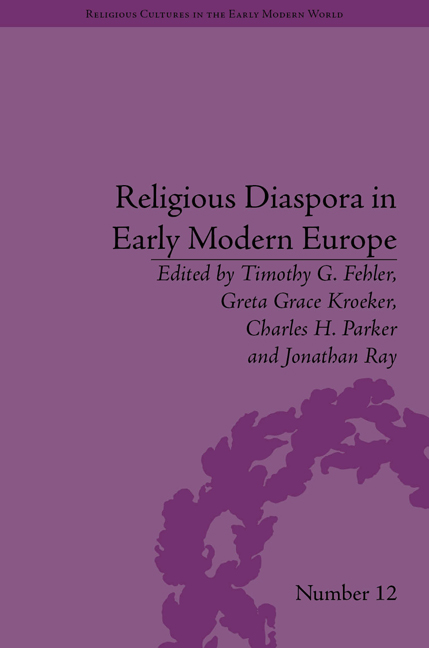37 results
5 - How Does an Embassy Work?
-
-
- Book:
- Diplomatic Tradecraft
- Published online:
- 15 March 2024
- Print publication:
- 28 March 2024, pp 100-124
-
- Chapter
- Export citation
Acknowledgements
-
- Book:
- Religious Diaspora in Early Modern Europe
- Published by:
- Pickering & Chatto
- Published online:
- 05 December 2014, pp ix-x
-
- Chapter
- Export citation
Part II - Programmes of Restoration
-
- Book:
- Religious Diaspora in Early Modern Europe
- Published by:
- Pickering & Chatto
- Published online:
- 05 December 2014, pp -
-
- Chapter
- Export citation
Part I - Tactics for Inclusion
-
- Book:
- Religious Diaspora in Early Modern Europe
- Published by:
- Pickering & Chatto
- Published online:
- 05 December 2014, pp -
-
- Chapter
- Export citation
Index
-
- Book:
- Religious Diaspora in Early Modern Europe
- Published by:
- Pickering & Chatto
- Published online:
- 05 December 2014, pp 235-247
-
- Chapter
- Export citation
List of Contributors
-
- Book:
- Religious Diaspora in Early Modern Europe
- Published by:
- Pickering & Chatto
- Published online:
- 05 December 2014, pp xi-xiv
-
- Chapter
- Export citation
Frontmatter
-
- Book:
- Religious Diaspora in Early Modern Europe
- Published by:
- Pickering & Chatto
- Published online:
- 05 December 2014, pp i-vi
-
- Chapter
- Export citation
Part III - Methods of Coping
-
- Book:
- Religious Diaspora in Early Modern Europe
- Published by:
- Pickering & Chatto
- Published online:
- 05 December 2014, pp -
-
- Chapter
- Export citation

Religious Diaspora in Early Modern Europe
- Strategies of Exile
-
- Published by:
- Pickering & Chatto
- Published online:
- 05 December 2014
-
- Book
- Export citation
CONTENTS
-
- Book:
- Religious Diaspora in Early Modern Europe
- Published by:
- Pickering & Chatto
- Published online:
- 05 December 2014, pp vii-viii
-
- Chapter
- Export citation
Notes
-
- Book:
- Religious Diaspora in Early Modern Europe
- Published by:
- Pickering & Chatto
- Published online:
- 05 December 2014, pp 181-234
-
- Chapter
- Export citation
List of Figures
-
- Book:
- Religious Diaspora in Early Modern Europe
- Published by:
- Pickering & Chatto
- Published online:
- 05 December 2014, pp xv-xvi
-
- Chapter
- Export citation
Contributors
-
-
- Book:
- Expansionary Fiscal Contraction
- Published online:
- 05 October 2014
- Print publication:
- 15 September 2014, pp ix-x
-
- Chapter
- Export citation
List of contributors
-
-
- Book:
- Nutrition in Critical Care
- Published online:
- 05 April 2014
- Print publication:
- 06 March 2014, pp viii-xii
-
- Chapter
- Export citation
Contributors
-
-
- Book:
- Trauma
- Published online:
- 07 September 2011
- Print publication:
- 16 June 2011, pp ix-xiv
-
- Chapter
- Export citation
Chapter 31 - Angiography and interventional radiology
- from Section 4 - Imaging in trauma
-
-
- Book:
- Trauma
- Published online:
- 07 September 2011
- Print publication:
- 16 June 2011, pp 540-550
-
- Chapter
- Export citation
Contents
-
- Book:
- Pain Management in Interventional Radiology
- Published online:
- 04 September 2009
- Print publication:
- 21 April 2008, pp v-vi
-
- Chapter
- Export citation
Contributors
-
- Book:
- Pain Management in Interventional Radiology
- Published online:
- 04 September 2009
- Print publication:
- 21 April 2008, pp vii-viii
-
- Chapter
- Export citation
Preface
-
- Book:
- Pain Management in Interventional Radiology
- Published online:
- 04 September 2009
- Print publication:
- 21 April 2008, pp ix-x
-
- Chapter
- Export citation
Index
-
- Book:
- Pain Management in Interventional Radiology
- Published online:
- 04 September 2009
- Print publication:
- 21 April 2008, pp 315-331
-
- Chapter
- Export citation



